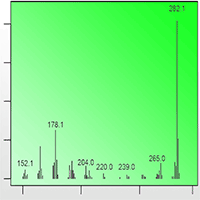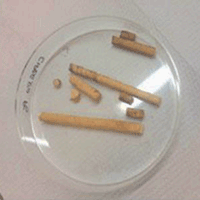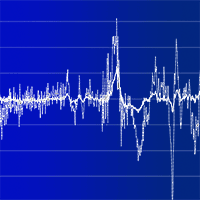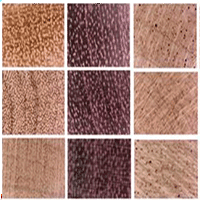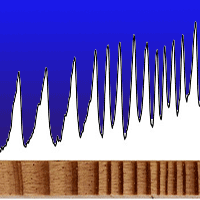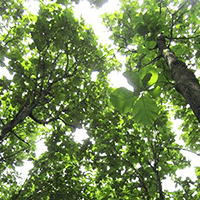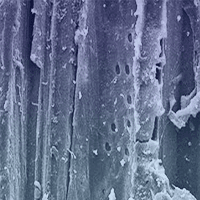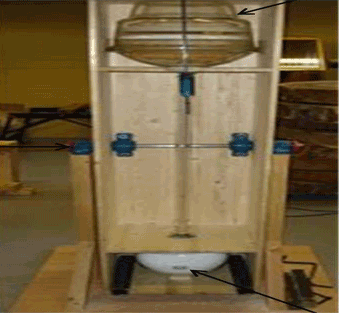Teak wood (Tectona grandis Linn F.) is known for its high natural resistance to attack by microorganisms. For this reason, teak wood is used for restoration works. This paper provides an assessment of the extraction capacity of various organic solvents and the chemical and physical-structural characteristics of extracts of teak wood with an age of 40 years. On the basis of literature data, we selected the solvents with potential synergetic activity in preservation treatments. For this purpose we used the SEM-EDX and GC+MS methods, assisted by computerized processing software, and corroborated the data obtained from these two instrumental techniques.
Keywords
, , , , ,
Citation
Colbu DE, Sandu I, Vasilache V, Earar K, Paraschiv ED, Sandu IG, Iliescu Bulgaru D, Sandu AV (2021). Study on the chemical composition of teak wood extracts in different organic solvents. iForest 14: 329-336. - doi: 10.3832/ifor3717-014
Academic Editor
Luigi Todaro
Paper history
Received: Dec 09, 2020
Accepted: May 06, 2021
First online: Jul 09, 2021
Publication Date: Aug 31, 2021
Publication Time: 2.13 months
© SISEF - The Italian Society of Silviculture and Forest Ecology 2021
Open Access
This article is distributed under the terms of the Creative Commons Attribution-Non Commercial 4.0 International (https://creativecommons.org/licenses/by-nc/4.0/), which permits unrestricted use, distribution, and reproduction in any medium, provided you give appropriate credit to the original author(s) and the source, provide a link to the Creative Commons license, and indicate if changes were made.

Breakdown by View Type
(Waiting for server response...)
Article Usage
Total Article Views: 38925
(from publication date up to now)
Breakdown by View Type
HTML Page Views: 32775
Abstract Page Views: 2684
PDF Downloads: 2824
Citation/Reference Downloads: 5
XML Downloads: 637
Web Metrics
Days since publication: 1617
Overall contacts: 38925
Avg. contacts per week: 168.51
Article Citations
Article citations are based on data periodically collected from the Clarivate Web of Science web site
(last update: Mar 2025)
Total number of cites (since 2021): 4
Average cites per year: 0.80
Publication Metrics
by Dimensions ©
Articles citing this article
List of the papers citing this article based on CrossRef Cited-by.
(1)
Aboaba S, Akande A, Flamini G (2014)Chemical constituents, toxicity and antimicrobial activities of the essential oil from the leaves of Tectona grandis. Elixir BioTechnology 75: 27384-27387.
Online |
Gscholar
(2)
ASTM International (2001)Standard test method for preparation of extractive-free wood. West Conshohocken, PA, USA.
Online |
Gscholar
(3)
Babar H, Mankowski ME, Kirker G, Ahmed S (2017)Effects of heartwood extractives on symbiotic protozoan communities and mortality in two termite species. International Biodeterioration and Biodegradation 123: 27-36.
CrossRef |
Gscholar
(4)
Bhat KM, Thulasidas PK, Florence EJM, Jayaraman K (2005)Wood durability of home-garden teak against brown-rot and white-rot fungi. Trees-Structure and Function 19: 654-660.
CrossRef |
Gscholar
(5)
Bolin CA, Smith S (2011)Life cycle assessment of ACQ-treated lumber with comparison to wood plastic composite decking. Journal of Cleaner Production 19: 620-629.
CrossRef |
Gscholar
(6)
Brocco VF, Paes JB, Da Costa LG, Brazolin S, Arantes MDC (2017)Potential of teak heartwood extracts as a natural wood preservative. Journal of Cleaner Production 142: 2093-2099.
CrossRef |
Gscholar
(7)
Burlage HM (1947)Pharmaceutical applications of isopropyl alcohol II. Solubilities of local anesthetics. Journal of the American Pharmaceutical Association 36: 17-19.
CrossRef |
Gscholar
(8)
Da Silva Leonardo FV, Rocha HF, Hurtado de Mendoza ZM (2015)Compostos químicos em teca [Chemical compounds in teak]. Pesquisa Florestal Brasileira 35 (83): 315. [in Portuguese]
CrossRef |
Gscholar
(9)
Deng Z (2006)Development of an alternative solvent to replace benzene in the determination of organic soluble extractives in wood. World Pulp and Paper 25: 32-34.
Online |
Gscholar
(10)
Dungani R, Bhat IH, Abdul Khalil HPS, Naif A, Hermawan D (2012)Evaluation of antitermitic activity of different extracts obtained from Indonesian teakwood (
Tectona grandis L.f). BioResources 7: 1452-1461.
CrossRef |
Gscholar
(11)
Feraydoni V, Hosseinihashemi SK (2012)Effect of walnut heartwood extractives, acid copper chromate, and boric acid on white-rot decay resistance of treated beech sapwood. BioResources 7: 2393-2402.
CrossRef |
Gscholar
(12)
Green MM, Wittcoff HA (2003)Organic chemistry principles and industrial practice. Wiley-VCH, Weinheim, Germany, pp. 341.
Online |
Gscholar
(13)
Haupt M, Leithoff H, Meier D, Puls J, Richter HG, Faix O (2003)Heartwood extractives and natural durability of plantation-grown teakwood (
Tectona grandis L.) a case study. Holz als Roh- und Werkstoff 61: 473-474.
CrossRef |
Gscholar
(14)
Hayashi M, Sandu I, Tiano P, Macchioni N (2010)The effect of preservative interventions on the chemical-physical and structural characteristics of panel painting. “Al. I. Cuza” University Publishing House, Iasi, Romania, pp. 130.
Gscholar
(15)
Hisamochi R, Watanabe Y, Sano M, Nakatsuka T, Kurita N, Matsuo-Ueda M, Yamamoto H, Tazuru S, Sugiyama J, Subiyanto B (2018)Cellulose oxygen isotopic composition of teak (
Tectona grandis) collected from Java Island: a tool for dendrochronological and dendroclimatological analysis. Dendrochronologia 52: 80-86.
CrossRef |
Gscholar
(16)
Iurcovschi CT, Munteanu M, Amariei CM, Lupascu MM, Sandu ICA, Vasilache V, Sandu I (2017)The impact of the treatment with Campeni red petroleum on a XVIII-th century icon. Chemistry Journal of Moldova 12: 53-60.
CrossRef |
Gscholar
(17)
Kartal SN, Terzi E, Yilmaz H, Goodell B (2015)Bioremediation and decay of wood treated with ACQ, micronized ACQ, nano-CuO and CCA wood preservatives. International Biodeterioration and Biodegradadation 99: 95-101.
CrossRef |
Gscholar
(18)
Kirker GT, Blodgett AB, Arango RA, Lebow PK, Clausen CA (2013)The role of extractives in naturally durable wood species. International Biodeterioration and Biodegradation 82: 53-58.
CrossRef |
Gscholar
(19)
Kopa TK, Tchinda AT, Tala MF, Zofou D, Jumbam R, Wabo HK, Titanji VPK, Frederich M, Tan NH, Tane P (2014)Antiplasmodial anthraquinones and hemisynthetic derivatives from the leaves of
Tectona grandis (Verbenaceae). Phytochemistry Letters 8: 41-45.
CrossRef |
Gscholar
(20)
Lacret R, Varela RM, Molinillo JMG, Nogueiras C, Macias FA (2012)Tectonoelins, new norlignans from a bioactive extract of
Tectona grandis. Phytochemistry Letters 5: 382-386.
CrossRef |
Gscholar
(21)
Lebow ST (2010)Wood preservation. Wood handbook-wood as an engineering material. General Technical Report FPL-GTR-190, USDA Forest Service, Forest Products Laboratory, Madison, WI, USA, pp. 1-28.
Online |
Gscholar
(22)
Lin LD, Chen YF, Wang SY, Tsai MJ (2009)Leachability, metal corrosion, and termite resistance of wood treated with copper-based preservative. International Biodeterioration and Biodegradation 63: 533-538.
CrossRef |
Gscholar
(23)
Luta N, Sandu I, Petreus O (2006)Produse si tehnologii pentru conservarea patrimoniului cultural si istoric [Products and technologies for the conservation of cultural and historical heritage]. Performantica, Iasi, Romania, pp. 286. [in Romanian]
Gscholar
(24)
Mburu F, Dumarçay S, Gérardin P (2007)Evidence of fungicidal and termicidal properties of
Prunus africana heartwood extractives. Holzforschung 61: 323-325.
CrossRef |
Gscholar
(25)
Mohammed SA, Madhan B, Demissie BA, Velappan B, Tamil Selvi A (2016)Rumex abyssinicus (mekmeko) Ethiopian plant material for preservation of goat skins: approach for cleaner leather manufacture. Journal of Cleaner Production 133: 1043-1052.
CrossRef |
Gscholar
(26)
Nakayama FS, Vinyard SH, Chow P, Bajwa DS, Youngquist JA, Muehl JH, Krzysik AM (2001)Guayule as a wood preservative. Industrial Crops and Products 14: 105-111.
CrossRef |
Gscholar
(27)
Niamke FB, Amusant N, Stien D, Chaix G, Lozano Y, Kadio AA, Lemenager N, Goh D, Adima AA, Kati-Coulibaly S, Jay-Allemand C (2012)4’,5’-Dihydroxy-epiisocatalponol, a new naphthoquinone from
Tectona grandis L. f. heartwood, and fungicidal activity. International Biodeterioration and Biodegradation 74: 93-98.
CrossRef |
Gscholar
(28)
NIST (2018)NIST standard reference database. SRD 69, NIST library, National Institute of Standards and Technology, US Secretary of Commerce, USA, web site.
CrossRef |
Gscholar
(29)
Okanlawon FB, Olaoye KO (2020)Bio preservative potential of
Ocimum basilicum L. leaf extract on
Triplochiton scleroxylon (K. Schum) and
Ceiba pentandra (L.) Gaertn. wood against termite attack. European Scientific Journal 16: 76-81.
CrossRef |
Gscholar
(30)
Paes JB, Brocco FV, Moulin JC, Motta JP, Alves RC (2015)Efeitos dos extrativos e da densidade na resistencia natural de madeiras ao termita
Nasutitermes corniger [Effect of extractives and density on natural resistance of woods to termite
Nasutitermes corniger]. CERNE 21: 569-578.
CrossRef |
Gscholar
(31)
Qiu H, Liu R, Long R (2019)Analysis of chemical composition of extractives by acetone and the chromatic aberration of Teak (
Tectona grandis L.f.) from China. Molecules 24: 1989.
CrossRef |
Gscholar
(32)
Reeve W, Erikson CM, Aluotto PF (1979)A new method for the determination of the relative acidities of alcohols in alcoholic solutions. The nucleophilicities and competitive reactivities of alkoxides and phenoxides. Canadian Journal of Chemistry 57: 2747-2754.
CrossRef |
Gscholar
(33)
Sandu I (2008)Degradarea si deteriorarea bunurilor de patrimoniu cultural [Degradation and deterioration of the cultural heritage]. “Al. I. Cuza” University Publishing House, Iasi, Romania, vol. II, pp. 538. [in Romanian]
Gscholar
(34)
Sandu I, Vasilache V, Sandu ICA, Hayashi M (2010)A new method of determining the normal range of hydric-equilibrium variation in wood, with multiple applications. Revista de Chimie 61: 1212-1218.
Online |
Gscholar
(35)
Sandu ICA, Brebu M, Luca C, Sandu I, Vasile C (2003)Thermogravimetric study on the ageing of lime wood supports of old paintings. Polymer Degradation and Stability 80: 83-91.
CrossRef |
Gscholar
(36)
Sandu ICA, Hayashi M, Vasilache V, Cozma DG, Pruteanu S, Urma M, Sandu I (2015)Influence of organic solvents and dispersions on wooden supports of paintings. Revista de Chimie 66: 587-595.
Online |
Gscholar
(37)
Schultz TP, Nicholas DD (2002)Development of environmentally-benign wood preservatives based on the combination of organic biocides with antioxidants and metal chelators. Phytochemistry 61: 555-560.
CrossRef |
Gscholar
(38)
Spiridon P, Sandu ICA, Nica L, Iurcovschi CT, Colbu DE, Negru IC, Vasilache V, Cristache RA, Sandu I (2017)Archaeometric and chemometric studies involved in the authentication of old heritage artefacts II. Old linden and poplar wood put into work. Revista de Chimie 68: 2422-2430.
CrossRef |
Gscholar
(39)
Syofuna A, Banana AY, Nakabonge G (2012)Efficiency of natural wood extractives as wood preservatives against termite attack. Maderas, Ciencia y Tecnologia 14: 155-163.
CrossRef |
Gscholar
(40)
Tascioglu C, Yalcin M, Sen S, Akcay C (2013)Antifungal properties of some plant extracts used as wood preservatives. International Biodeterioration and Biodegradation 85: 23-28.
CrossRef |
Gscholar
(41)
Thulasidas PK, Bhat KM (2007)Chemical extractive compounds determining the brown-rot decay resistance of teak wood. Holz als Roh- und Werkstoff 65: 121-124.
CrossRef |
Gscholar
(42)
Vasilache V, Sandu I, Luca C, Sandu ICA (2009)Noutati în conservarea stiintfica a lemnului vechi policrom [News concerning scientific conservation of the old polychrome wood]. “Al. I. Cuza” University Publishing House, Iasi, Romania, pp. 282. [in Romanian]
Gscholar
(43)
Walker JCF, Butterfield BG, Harris JM, Langrish TAG, Uprichard JM (1993)Primary wood processing. principles and practice. Chapman and Hall, London, UK, pp. 611.
Gscholar
(44)
Wang L, Chen SS, Tsang DCW, Poon CS, Shih K (2016)Recycling contaminated wood into eco-friendly particleboard using green cement and carbon dioxide curing. Journal of Cleaner Production 137: 861-870.
CrossRef |
Gscholar
(45)
Xie C, Li K, Lin J, Li J (2011)GC-MS analysis on heartwood extractive chemical components of different provenances of Teak (
Tectona grandis L.f.). Advanced Materials Research 236 (238): 1049-1053.
CrossRef |
Gscholar
(46)
Yatagai M, Nishimoto M, Hori K, Ohira T, Shibata A (2002)Termiticidal activity of wood vinegar, its components and their homologues. Journal of Wood Science 48: 338-342.
CrossRef |
Gscholar
(47)
Yaws CL (1999)Chemical properties handbook: physical, thermodynamics, environmental transport, safety and health related properties for organic and inorganic chemical. McGraw-Hill, New York, USA, pp. 784.
Gscholar


